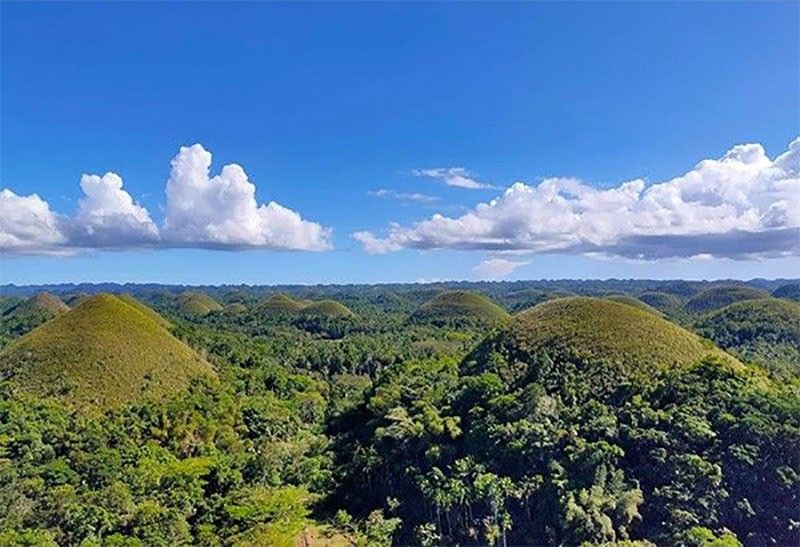DILG creates Chocolate Hills task force

Senators vow probe on lapses by national, local agencies
MANILA, Philippines — Department of the Interior and Local Government (DILG) Secretary Benjamin Abalos Jr. has ordered the creation of a special investigation team to determine the liability of local government officials responsible for the issuance of permit to a private group for the construction and operation of a resort at the Chocolate Hills in Bohol.
“The DILG affirms its deep concern over the construction of the Captain’s Peak resort within the hallowed grounds of Bohol’s Chocolate Hills. We have mobilized a special investigation team to swiftly ascertain any liability of local officials in this matter,” Abalos said in a statement.
He said the site is a protected area under Proclamation No. 1037, series of 1997 and Republic Act No. 7586 or the National Integrated Protected Areas System (NIPAS) Act of 1992.
Environment Secretary Maria Antonia Yulo-Loyzaga has blamed local officials of Sagbayan, Bohol for allowing the construction of Captain’s Peak Resort at the Chocolate Hills, a UNESCO World Heritage Site.
She said local government units issued permits despite the failure of the resort operator to secure an environmental compliance certificate (ECC) from the Department of Environment and Natural Resources (DENR).
Abalos said erring local officials could face suspension or dismissal depending on the gravity of their offenses.
“Local officials found complicit or negligent with respect to any violation will face legal action. These officials may be suspended or dismissed. We will continue to uphold accountability and integrity in public service,” he added.
Amid the controversy, provincial board member Jiselle Rae Villamor said the DENR should make an accounting of all tourism-related resorts or establishments within protected areas and submit a list of such establishments to the Sangguniang Panlalawigan.
Aside from Captain’s Peak, other tourism-related establishments within the Chocolate Hills area are the Sagbayan Peak in Sagbayan town and Bud Agta in Barangay Buenos Aires in Carmen town. Bud Agta even has a wooden ladder leading to a view deck atop one of the hills.
As chair of the environment committee in the provincial board, Villamor initiated an investigation last year on possible violations of environment laws in the Chocolate Hills area by tourist spot operators. Provincial board member Nathaniel Binlod called for an investigation in a privilege speech after the UNESCO designated Bohol as a world geo-park.
PAMB go-signal
The investigation has revealed that the resort was issued a mayor’s permit and allowed to operate at the Chocolate Hills by the Protected Area Management Board (PAMB).
“The hills should not be altered nor defaced and extraction is strictly prohibited,” according to PAMB in Resolution No. 01 in 2018 allowing the operation of Captain’s Peak Garden Eco-park Tourism resort in Barangay Canmano, Sagbayan town.
While board members noted the construction of cottages and two water slides for a swimming pool at the foot or on the slope of one of the hills, they said the construction did not violate the rule limiting such projects to 20 percent of the size of the hill.
In a statement, Rep. Vanessa Amentado said Captain’s Peak resort had been ordered closed to give way to an investigation.
“I am a firm believer and supporter of preserving and conserving our natural resources. I believe that in doing so, we preserve our lives and the lives of the future generations,” she said.
The DENR said it had issued a temporary closure order (TCO) on Captain’s Peak way back in September 2023 and a Notice of Violation on Jan.22, 2024.
DENR regional executive director Paquito Melicor ordered provincial environment and natural resources officer Ariel Rica to investigate violations committed by the resort.
Meanwhile, Senators Nancy Binay and Cynthia Villar have vowed to initiate a probe on the Chocolate Hills controversy.
Binay said a Senate inquiry should cover the construction of other structures near the cone-shaped hills, such as Bud Agta.
She lamented that the issue only came to light after photos posted on social media went viral.
“It was clear that there was something wrong with the issuance of a permit for these structures,” she said.
Delisting unlikely
The senator, however, doused fears that the controversy could result in the removal of Bohol from the UNESCO Global Geo-park list.
“There will be time given to explain what happened and measures to be made. It takes time for the removal from the UNESCO list,” Binay said.
It was UNESCO Artist for Peace and Ramon Magsaysay awardee Cecile Guidote-Alvarez who sounded the alarm over the possible delisting of Bohol as a geo-park due to the controversy.
“If you are given an honor, you have the responsibility to protect it. You can be delisted and have the bestowed honor taken back,” Alvarez said over radio dzRH yesterday.
“UNESCO also investigates as a United Nations program. If this issue reaches UNESCO, there is a danger of delisting, although not instantly. They will look at the actions taken,” she added.
Villar, who chairs the Senate environment and natural resources committee, said LGUs and the DENR – through PAMB – should have prevented outright the construction of structures in a protected area.
She said the PAMB should have prevented the resort owners from applying for clearance to build commercial structures in a protected area, because it is prohibited under the expanded National Integrated Protected Areas System (NIPAS) law.
Under the NIPAS law, PAMBs are assigned to each protected area for safeguarding. The board is composed of a DENR regional director, a senator, as well as other officials whose jurisdictions cover a protected area.
“The officials cannot say they did not know about this. They should have full knowledge,” Villar said.
Even though the resort owners claim to have a title to the land, they should still seek clearance from the PAMB and get an ECC before building structures on a legislated protected area, Villar said.
The Chocolate Hills Natural Monument is among the 247 protected areas in the Philippines. — Marc Jayson Cayabyab, Ric Obedencio
- Latest
- Trending

































